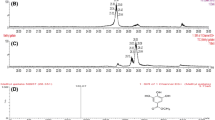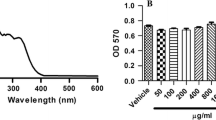Abstract
Ginseng, one of the most widely used herbal medicines, has a wide range of therapeutic and pharmacological applications. Ginsenosides are the major bioactive ingredients of ginseng, which are responsible for various pharmacological activities of ginseng. Ginsenoside Rh2, known as an antitumour ginsenoside, exists as two different stereoisomeric forms, 20(S)-ginsenoside Rh2 [20(S)-Rh2] and 20(R)-ginsenoside Rh2 [20(R)-Rh2]. This work aimed to assess and compare skin anti-photoaging activities of 20(S)-Rh2 and 20(R)-Rh2 in UV-B-irradiated HaCat cells. 20(S)-Rh2, but not 20(R)-Rh2, was able to suppress UV-B-induced ROS production in HaCat cells. Both stereoisomeric forms could not modulate cellular survival and NO level in UV-B-irradiated HaCat cells. Both 20(S)-Rh2 and 20(R)-Rh2 exhibited suppressive effects on UV-B-induced MMP-2 activity and expression in HaCat cells. In brief, the two stereoisomers of ginsenoside Rh2, 20(S)-Rh2 and 20(R)-Rh2, possess skin anti-photoaging effects but possibly in different fashions.






Similar content being viewed by others
Abbreviations
- MMP:
-
matrix metalloproteinase
- NO:
-
nitric oxide
- 20(R)-Rh2:
-
20(R)-ginsenoside Rh2
- 20(S)-Rh2:
-
20(S)-ginsenoside Rh2
- ROS:
-
reactive oxygen species
References
Aitken GR, Henderson JR, Chang SC, McNeil CJ and Birch-Machin MA 2007 Direct monitoring of UV-induced free radical generation in HaCaT keratinocytes. Clin. Exp. Dermatol. 32 722–727
Aoki-Yoshida A, Aoki R and Takayama Y 2013 Protective effect of pyruvate against UVB-induced damage in HaCaT human keratinocytes. J. Biosci. Bioeng. 115 442–448
Bae EA, Han MJ, Kim EJ and Kim DH 2004 Transformation of ginseng saponins to ginsenoside Rh2 by acids and human intestinal bacteria and biological activities of their transformants. Arch. Pharm. Res. 27 61–67
Baek NI, Kim DS, Lee YH, Park JD, Lee CB and Kim SI 1996 Ginsenoside Rh4, a genuine dammarane glycoside from Korean red ginseng. Planta Med. 62 86–87
Barresi C, Stremnitzer C, Mlitz V, Kezic S, Kammeyer A, Ghannadan M, Posa-Markaryan K, Selden C, et al. 2011 Increased sensitivity of histidinemic mice to UVB radiation suggests a crucial role of endogenous urocanic acid in photoprotection. J. Invest. Dermatol. 131 188–194
Birch-Machin MA and Swalwell H 2010 How mitochondria record the effects of UV exposure and oxidative stress using human skin as a model tissue. Mutagenesis 25 101–107
Curran S and Murray GI 1999 Matrix metalloproteinases in tumour invasion and metastasis. J. Pathol. 189 300–308
Freshney RI 1994 Culture of animal cells: a manual of basic technique 4th edition (New York: Wiley-Liss Press)
Hwang JT, Kim SH, Lee MS, Kim SH, Yang HJ, Kim MJ, Kim HS, Ha J, et al. 2007 Anti-obesity effects of ginsenoside Rh2 are associated with the activation of AMPK signaling pathway in 3T3-L1 adipocyte. Biochem. Biophys. Res. Commun. 364 1002–1008
Ichihashi M, Ueda M, Budiyanto A, Bito T, Oka M, Fukunaga M, Tsuru K and Horikawa T 2003 UV-induced skin damage. Toxicology 189 21–39
Ikehata H and Ono T 2011 The mechanisms of UV mutagenesis. J. Radiat. Res. 52 115–125
Jenkins G 2002 Molecular mechanisms of skin ageing. Mech. Ageing. Develop. 123 801–810
Kähäri VM and Saarialho-Kere U 1997 Matrix metalloproteinases in skin. Exp. Dermatol. 6 199–213
Kim JA, Ahn BN, Kong CS and Kim SK 2012 Protective effect of chromene isolated from Sargassum horneri against UV-A-induced damage in skin dermal fibroblasts. Exp. Dermatol. 21 630–631
Kleiner DE and Stetler-Stevenson WG 1994 Quantitative zymography: detection of picogram quantities of gelatinases. Anal. Biochem. 218 325–329
Koźák I, Klisenbauer D and Juhás T 2003 UV-B induced production of MMP-2 and MMP-9 in human corneal cells. Physiol. Res. 52 229–234
Krolikiewicz-Renimel I, Michel T, Destandau E, Reddy M, André P, Elfakir C and Pichon C 2013 Protective effect of a Butea monosperma (Lam.) Taub. flowers extract against skin inflammation: Antioxidant, anti-inflammatory and matrix metalloproteinases inhibitory activities. J. Ethnopharmacol. 148 537–543
Lee YM, Kim YK, Kim KH, Park SJ, Kim SJ and Chung JH 2009 A novel role for the TRPV1 channel in UV-induced matrix metalloproteinase (MMP)-1 expression in HaCaT cells. J. Cell. Physiol. 219 766–775
Liu J, Shimizu K, Yu H, Zhang C, Jin F and Kondo R 2010 Stereospecificity of hydroxyl group at C-20 in antiproliferative action of ginsenoside Rh2 on prostate cancer cells. Fitoterapia 81 902–905
Liu J, Shiono J, Shimizu K, Yu H, Zhang C, Jin F and Kondo R 2009 20(R)-ginsenoside Rh2, not 20(S), is a selective osteoclastgenesis inhibitor without any cytotoxicity. Bioorg. Med. Chem. Lett. 19 3320–3323
Park EK, Choo MK, Kim EJ, Han MJ and Kim DH 2003 Antiallergic activity of ginsenoside Rh2. Biol. Pharm. Bull. 26 1581–1584
Park NH, Park JS, Kang YG, Bae JH, Lee HK, Yeom MH, Cho JC and Na YJ 2013 Soybean extract showed modulation of retinoic acid-related gene expression of skin and photo-protective effects in keratinocytes. Int. J. Cosmet. Sci. 35 136–142
Paz ML, González Maglio DH, Weill FS, Bustamante J and Leoni J 2008 Mitochondrial dysfunction and cellular stress progression after ultraviolet B irradiation in human keratinocytes. Photodermatol. Photoimmunol. Photomed. 24 115–122
Pygmalion MJ, Ruiz L, Popovic E, Gizard J, Portes P, Marat X, Lucet-Levannier K, Muller B, et al. 2010 Skin cell protection against UVA by sideroxyl, a new antioxidant complementary to sunscreens. Free Radic. Biol. Med. 49 1629–1637
Quan T, Qin Z, Xia W, Shao Y, Voorhees JJ and Fisher GJ 2009 Matrix-degrading metalloproteinases in photoaging. J. Invest. Dermatol. Symp. Proc. 14 20–24
Rittié L and Fisher GJ 2002 UV-light-induced signal cascades and skin aging. Ageing Res. Rev. 1 705–720
Royall JA and Ischiropoulos H 1993 Evaluation of 2’,7’-dichlorofluorescin and dihydrorhodamine 123 as fluorescent probes for intracellular H2O2 in cultured endothelial cells. Arch. Biochem. Biophys. 302 348–355
Seité S, Colige A, Piquemal-Vivenot P, Montastier C, Fourtanier A, Lapière C and Nusgens B 2000 A full-UV spectrum absorbing daily use cream protects human skin against biological changes occurring in photoaging. Photodermatol. Photoimmunol. Photomed. 16 147–155
Sherman MP, Aeberhard EE, Wong VZ, Griscavage JM and Ignarro LJ 1993 Pyrrolidine dithiocarbamate inhibits induction of nitric oxide synthase activity in rat alveolar macrophages. Biochem. Biophys. Res. Commun. 191 1301–1308
Trinh HT, Han SJ, Kim SW, Lee YC and Kim DH 2007 Bifidus fermentation increases hypolipidemic and hypoglycemic effects of red ginseng. J. Microbiol. Biotechnol. 17 1127–1133
Werb Z 1997 ECM and cell surface proteolysis: regulating cellular ecology. Cell 91 439–442
Zhang C, Yu H and Hou J 2011 Effects of 20(S)-ginsenoside Rh2 and 20(R)-ginsenoside Rh2 on proliferation and apoptosis of human lung adenocarcinoma A549 cells. Zhongguo Zhong Yao Za Zhi 36 1670–1674
Zhang J, Zhou F, Niu F, Lu M, Wu X, Sun J and Wang G 2012 Stereoselective regulations of P-glycoprotein by ginsenoside Rh2 epimers and the potential mechanisms from the view of pharmacokinetics. PLoS One 7 e35768
Acknowledgements
This study was supported by a grant of the Korea Healthcare Technology R&D Project, Ministry of Health & Welfare, Republic of Korea (Grant No. : A103017). This study was also supported by 2014 Research Grant from Kangwon National University (No. 120140161).
Author information
Authors and Affiliations
Corresponding author
Additional information
Corresponding editor: B JAGADEESHWAR RAO
[Oh S-J, Lee S, Choi W-Y and Lim C-J 2014 Skin anti-photoaging properties of ginsenoside Rh2 epimers in UV-B-irradiated human keratinocyte cells. J. Biosci. 39 1–10] DOI 10.1007/s12038-014-9460-x
These authors contributed equally to this work.
Rights and permissions
About this article
Cite this article
Oh, SJ., Lee, S., Choi, WY. et al. Skin anti-photoaging properties of ginsenoside Rh2 epimers in UV-B-irradiated human keratinocyte cells. J Biosci 39, 673–682 (2014). https://doi.org/10.1007/s12038-014-9460-x
Received:
Accepted:
Published:
Issue Date:
DOI: https://doi.org/10.1007/s12038-014-9460-x




